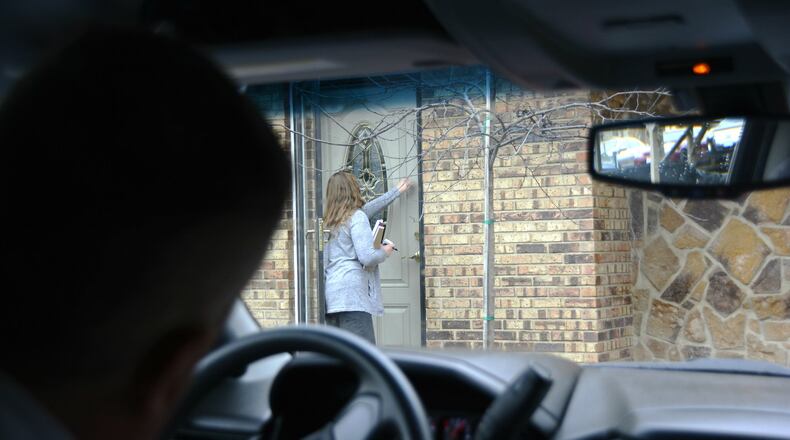The Journal-News recently traveled with the quick response team in Fairfield to learn what the teams do and the effect they have. About 60 of the 778 fatal drug overdoses from 2015-18 happened in Fairfield, and 40 of those victims were Fairfield residents.
The quick response teams travel to connect with those who have overdosed and offer them a variety of help.
“I think it’s worth our time to follow up on all the (calls),” said Fairfield Deputy Fire Chief Tom Wagner, who rides on the QRT.
Fairfield police Maj. Greg Valandingham, who also rides on the QRT, said it’s “also fulfilling our mission to serve people.”
Similar teams are in several other Butler County communities, including Hamilton, Middletown and Oxford. The Butler County Sheriff’s Office also operates a team.
“It’s an opportunity to educate people and hopefully head off some future issues. Rather than being reactive all the time, we’re being proactive,” Valandingham said.
Fairfield formed its quick response team several years ago, and it made 37 home visits to attempt to contact people who overdosed in 2018. Those first attempts don't often result in direct contact with addicts, but Victoria Hensley, a care counselor with the Butler County Heroin HopeLine, which is part of One City Against Heroin, said they consistently reach out to addicts.
Hensley said she made contact with 25 people who overdosed, and nine went into some type of treatment.
“It seems low, but when someone’s using for so long, just to get the interaction is so huge; to get them receptive, to get them even talking with me, and then accepting the referrals. I think it’s awesome,” she said.
Erasing the stigma
When a paramedic or a police officer is called to a drug overdose, the victim often will give an old address, or one for an ex-boyfriend or ex-girlfriend, which can make later contact difficult.
“It could be hit or miss,” Valandingham said. “Sometimes you have contact with the actual person, and they have no interest in taking the information. But more times than not they’ll take the information.”
A lot of that has to do with the stigma, said Amy Parker, Peer Recovery Specialist and Community Outreach Manager with BrightView, a regional outpatient substance abuse treatment center with a location on Sandy Lane in Fairfield.
“Many might think the only kind of treatment available is inpatient for 30 days, and that may not work if they only have Medicaid, or no insurance,” she said. “But that’s not the case.”
Butler and Hamilton counties have “a ton of treatment centers” that range from inpatient and outpatient treatment centers to counseling services, Parker said.
“There is a lot of availability for treatment out there, but it’s the stigma and there are a lot of barriers that might keep people from coming to treatment,” she said.
Other barriers include lack of insurance or Medicaid or belief that the costs are too expensive for them.
But Parker said help is available in spite of the believed barriers because some treatment can be covered through grants or charitable organizations.
“It’s just plugging into the right people and just knowing what programs are out there, and going from there. And engaging people. And treating us like humans,” said Parker, a former opioid and heroin addict.
Recovering addict
Parker was an addict for nearly two decades before she almost died seven years ago while living in Indianapolis. She was addicted to opioids for 16 years before she turned to heroin for a few years, she said.
Then she overdosed and was revived with Narcan.
But Parker’s wake-up call came about six weeks later.
“I decided, ‘Alright. I’m done. I have no more money. I have no needles, I just overdosed recently. I’m in this horrible toxic, abusive relationship. Either I just need to kill myself or I need to change my life,’” she said. “And clearly killing myself wasn’t working.”
That was in February 2012.
She went to the nearest emergency room in Indianapolis, which had a dual diagnosis unit, and told the ER nurse she had a plan to commit suicide. Officials placed her on suboxone, went through withdraw and provided therapy, “and that was what I needed to just get past the initial part of it. And a whole lot of work for several years, and still today I still put in a whole lot of work, but it’s not as difficult today.”
Her overdose was right before heroin was being cut with fentanyl and carfentanil.
“If I would have continued using I would already be dead,” she said. “I already overdosed, I was using black tar heroin from the Mexican drug cartel. There’s no other reason that God wanted me here today for the sole purpose of what I’m doing today with my life. And that’s why I didn’t die.”
Awareness and compassion
There are no goals or target numbers for the QRT. If one life is saved, the program is worth it, Hensley said.
“We need to let people know there is help out here,” Hensley said. “You call this number (Heroin HopeLine) and someone’s going to answer the phone. Addiction is not a Monday through Friday, 8 to 5 problem.”
But awareness is key, said Hensley and Parker. The QRT is one way to build awareness, but Parker said, “Whereever we can connect with someone with substance use disorder — whether it’s the hospital, a jail, a nursing home, out in the street — the component that’s needed to reach someone is compassion.
“As long as we are showing compassion in a non-judgmental way, no matter who it is, that’s what’s needed to really reach someone on a level to say, ‘Hey, I see what you’re going through, I care about you.’”
About the Author



